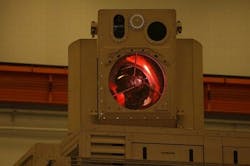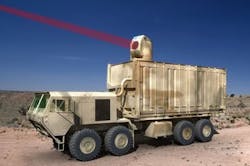Aculight gets long-delayed contract for a 60-kilowatt laser to shoot down rockets, mortars, UAVs
HUNTSVILLE, Ala., 3 March 2014.Laser weapons experts at Lockheed Martin Aculight in Bothell, Wash., won a long-delayed contract Friday to develop a 60-kilowatt fiber laser module for a truck-mounted laser weapon system intended to shoot down enemy unmanned aerial vehicles (UAVs), rockets, artillery rounds, and mortars.
Officials of the Army Space and Missile Defense Command in Huntsville, Ala., announced a $25.2 million contract to Aculight for a 60 kilowatt spectrally combined high-power fiber laser for the High Energy Laser Mobile Demonstrator (HEL MD) -- a joint project of the Army and the Boeing Co. Directed Energy Systems segment in St. Louis.
Army officials had announced their intention to award this three-year sole-source contract to Lockheed Martin Aculight last August. The HEL MD will operate on Army and U.S. Department of Defense test ranges and other outdoor locations. The contract runs through the end of 2016.
In a related action, Army Space and Missile Defense Command officials sent out a request to industry last month to supply an adjustable-power 50-kilowatt laser that with its cooling subsystem can fit on an 8-by-53-foot full-sized flatbed trailer.
Related: Army asks industry for turn-key 50-kilowatt laser that fits on 8-by-53-foot truck trailer
Army researchers are asking Aculight experts to capitalize on technology developed under the U.S. military's Robust Electric Laser Initiative (RELI) to increase laser weapons power from the 25 kilowatts demonstrated previously in the RELI program to 60 kilowatts. The HEL MD program is intended to develop a laser weapon to counter airborne threats with lasers of 50 to 100 kilowatts.
Aculight will build and integrate additional RELI 2-kilowatt fiber laser modules identical to those required for the RELI 25-kilowatt laboratory laser, to reach 60 kilowatts output power, Army officials explain.
Aculight experts also will characterize the RELI beam combining fiber array and spectral beam combiner for the higher thermal loading imposed by the increased power.
Related: Lockheed Martin Aculight to develop 60-kilowatt laser to kill UAVs, rockets, and mortars
This 60-kilowatt laser will be integrated into the HEL MD to support an upcoming demonstration to counter enemy UAVs, rockets, incoming artillery shells, and mortars.
This project is a continuation of a succession of laser weapons research programs to ratchet-up the power of laser beams to make them strong enough for future generations of laser weapons.
The RELI project builds on laser weapons technologies developed earlier in the Joint High Power Solid State Laser (JHPSSL) and the High Energy Liquid Laser Area Defense System (HELLADS) programs. RELI was a follow-on project to capitalize on technologies developed in JHPSSL and HELLADS.
Related: Boeing high energy laser system continues to high-power testing
The JHPSSL and HELLADS projects developed technologies for packaging, cooling, and fire-control capability for future laser weapons. The RELI program has focused on drastic improvements in laser efficiencies, as well as in packaging small enough for deployable laser weapons on tactical aircraft and vehicles.
The RELI program involves Raytheon Space Systems in El Segundo, Calif.; the Boeing Directed Energy Program in Albuquerque N.M., and Lockheed Martin Aculight. Partners on the RELI program are the Army and U.S. Air Force. The U.S. Navy also is expected to get involved.
For more information contact Lockheed Martin Aculight online at www.lockheedmartin.com/us/products/aculight, or the Army Space and Missile Defense Command at www.army.mil/info/organization/unitsandcommands/commandstructure/smdc.

John Keller | Editor
John Keller is editor-in-chief of Military & Aerospace Electronics magazine, which provides extensive coverage and analysis of enabling electronic and optoelectronic technologies in military, space, and commercial aviation applications. A member of the Military & Aerospace Electronics staff since the magazine's founding in 1989, Mr. Keller took over as chief editor in 1995.


